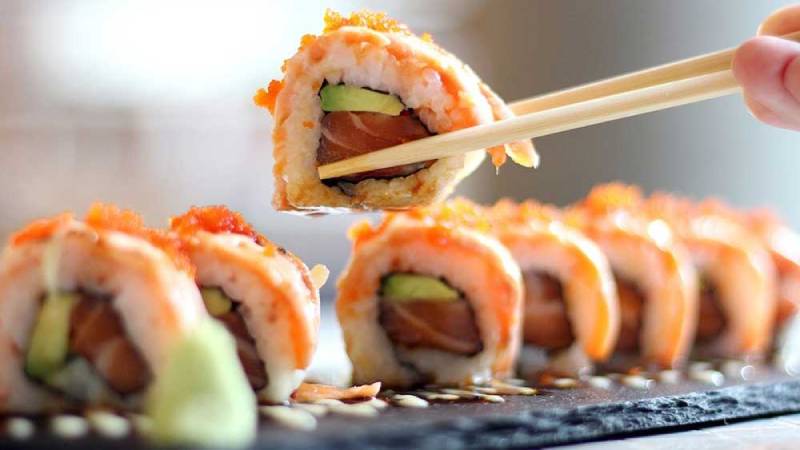Grab your hashi (Japanese chopsticks) and enjoy your favorite sushi rolls.
In honor of International Sushi Day on June 18, here are five things to know about Japan’s contribution to the popular dish.
1. Raw seafood isn’t a requirement
According to chef Andy Matsuda, who runs the Sushi Chef Institute in Torrance, California, traditional sushi certainly includes some form of raw seafood, but it’s not a requirement.
In Japanese, sushi means “sour rice.”
Sushi doesn’t have to include raw fish, or any fish, to be considered sushi, Matsuda says.
He said the only ingredient needed was vinegared rice.
Matsuda says that eating raw fish became common in Japan’s Tokyo Bay area only a few hundred years ago.
Other types of sushi also include cooked seafood, vegetables, and other meats.
Examples of sushi rolls that don’t contain raw fish include avocado rolls, Boston rolls, California rolls, and dragon rolls, to name a few.
Temaki (rice and ingredients wrapped in nori seaweed) is also a type of sushi, Matsuda says.
2. ‘The green stuff’ explained
What are those globs of spicy green paste that come with sushi?
Spam Blizzard: The center of a sushi miracle popular around the world since World War II
Though commonly known as a wasabi ball, Matsuda said this is not “real vegetable wasabi.”
Rather, he said this is a mix of horseradish, mustard powder and green food coloring.
People who are unfamiliar with sushi tend to mix wasabi with soy sauce to make a kind of “paste-like ketchup,” Matsuda said.
But the Japanese wouldn’t eat it that way, he said.
“We never do that,” Matsuda, a native of Kobe, Japan, told Fox News Digital.
In reality, he said, the wasabi in most Japanese restaurants in the U.S. isn’t so “crazy hot,” so no one who eats it will mind the spiciness.
Still, Matsuda said, it’s not something you eat like guacamole at a Mexican restaurant.
3. Safe for beginners
Matsuda’s recommendation for first-time sushi eaters is the California roll.
The California roll has rice on the outside and crab meat, avocado, and cucumber on the inside.
Because avocado is not available in Japan, Matsuda said the California roll was “for more American people – easy to eat.”
Matsuda also recommends lighter fish like mackerel or tuna, but if eating raw fish is too “hard” for those new to the sushi world, he recommends cooked ones like shrimp or eel, “sweet sauces on it.”
4. Preparation is an art
Japanese chefs teach themselves how to prepare sushi properly, and it can take years to perfect the technique, Matsuda says.
That’s because Japanese sushi chefs don’t train other chefs step by step, Matsuda says.
“That’s a Japanese sushi chef society,” he said. “They don’t teach you. They don’t share with you.”
In the United States, aspiring sushi chefs can take a two-month course at a school like Matsuda’s Sushi Chef Institute to learn the craft of sushi making.
Matsuda said students learn everything from how to cut different types of fish, how to sharpen knives, how to properly wash and cook rice.
“We need to have a lot of knowledge and experience,” he said.
5. A sushi chef brings your food to you
For sushi lovers who don’t get out much, a sushi chef brings your food to you.
Tomas Iribarren is CEO and executive chef of Irimaki Live Sushi Catering, which he founded in 2020.
Born out of the pandemic, the South Florida-based live catering company specializes in Japanese-inspired dishes, appetizers, sushi rolls and desserts, Iribarren told Fox News Digital.
Irimaki and similar companies offer customers a live sushi-cooking experience.
“This is mostly a service for wealthy individuals,” Iribarren noted.
He added that he has hosted everything from birthdays, graduation parties and dinners at his home to get-togethers for travelers staying in Airbnb’s.
- Top 5 Netflix Films with Engaging and Better Storylines - December 23, 2024
- Lauren Sanchez: Everything to Know About Jeff Bezos’ Fiancee - December 23, 2024
- Lose Weight Faster: Top 5 Cardio Workouts to Try Today - December 23, 2024





